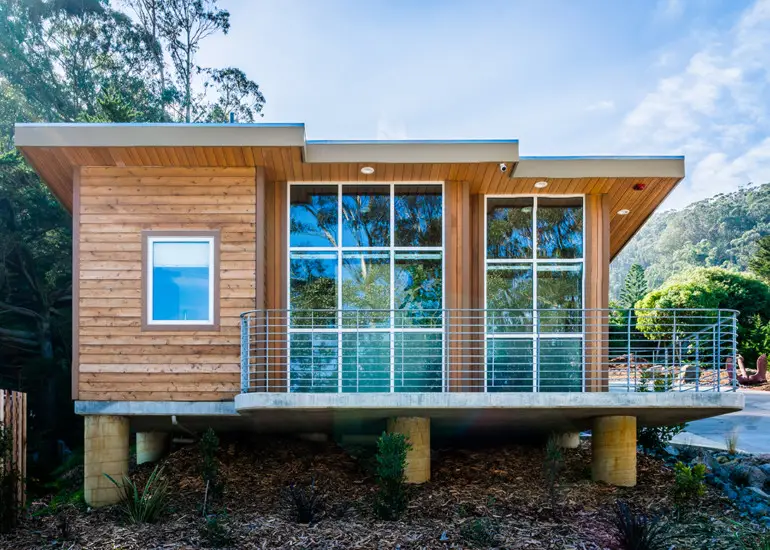WHEN IT COMES to retaining a sustainable way of life, California, like many parts of the U.S., is on a precipice. Recent years have brought drought and ravaging fires, and our land and housing prices are among the highest in the nation— requiring new thinking from businesses and government agencies. But residents can also do something to ease strain on land use: live smaller.
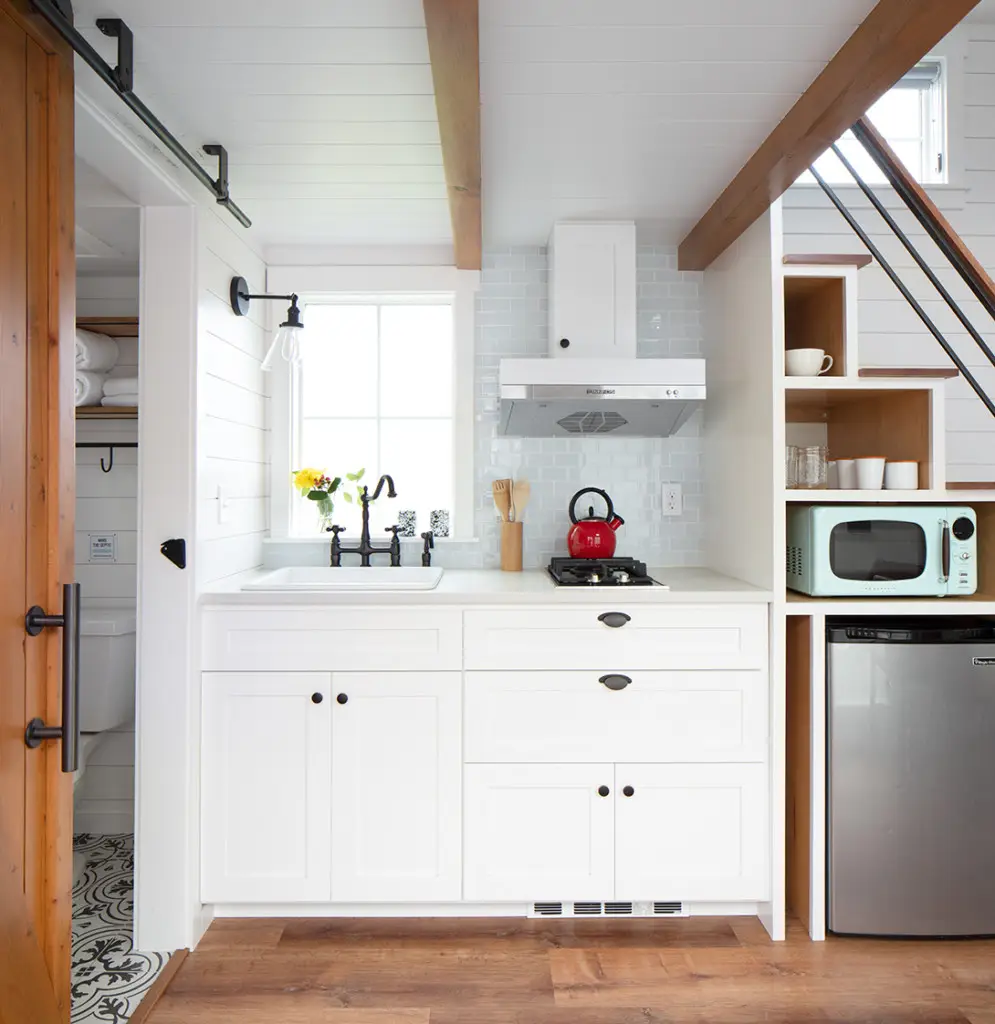
Once upon a time, what we now call small houses were mainly for outdoor types living in one-room wilderness cabins or people needing temporary digs while building or buying a house. No more. Small homes are popping up all over as long-term solutions to housing shortages. Living small has many benefits, from a smaller tax bill to a reduced carbon footprint, and it’s catching on as a popular trend.
Of course, as an idea, living small (or smaller) is not new. In California, its modernized form dates back at least to the 1960s, when The Sea Ranch, in coastal Sonoma County, was conceived. For that residential project, architects and designers challenged themselves to prove humans could live in a fragile natural environment without destroying it. The development evolved into an intentional community grounded in environmental stewardship and community service.
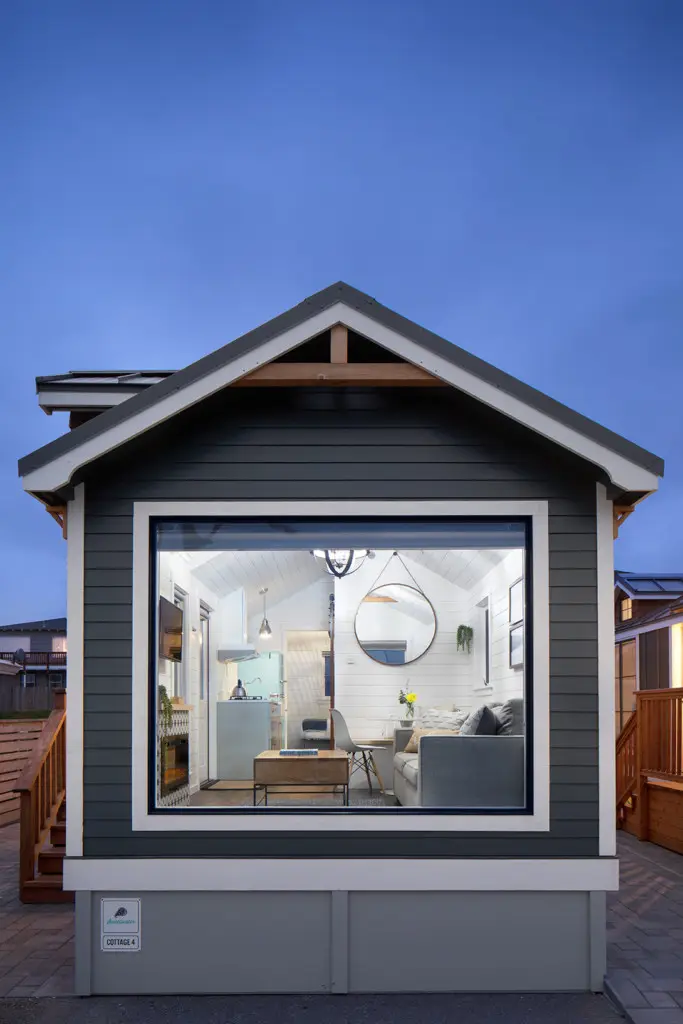
Jim Soules, now principal architect at Soules Company in Seattle, was a student at UC Berkeley at the time and took notice of The Sea Ranch properties’ careful design. “The thought of compact, quality homes was bubbling in the design and urban planning communities,” he says. After Berkeley, he worked as a planner for Marin County, then moved into residential development to raise awareness of the possibilities for thoughtful smaller-scale design. Early reaction to his first projects, in the 1970s, was tepid: “People were like, ‘Who would do that?” He recalls.
But attitudes continued to change. In the early 2000s, Sarah Susanka authored a series of books with titles like The Not So Big House about how to live well in 1,500 to 2,500 square feet. Soules shared her view that “you invest in quality and good design rather than just space,” he says, acquiring a few really nice items rather than lots of possessions. “It is not about quantity, but quality.”
California Tiny Homes
Kellercourt Commons
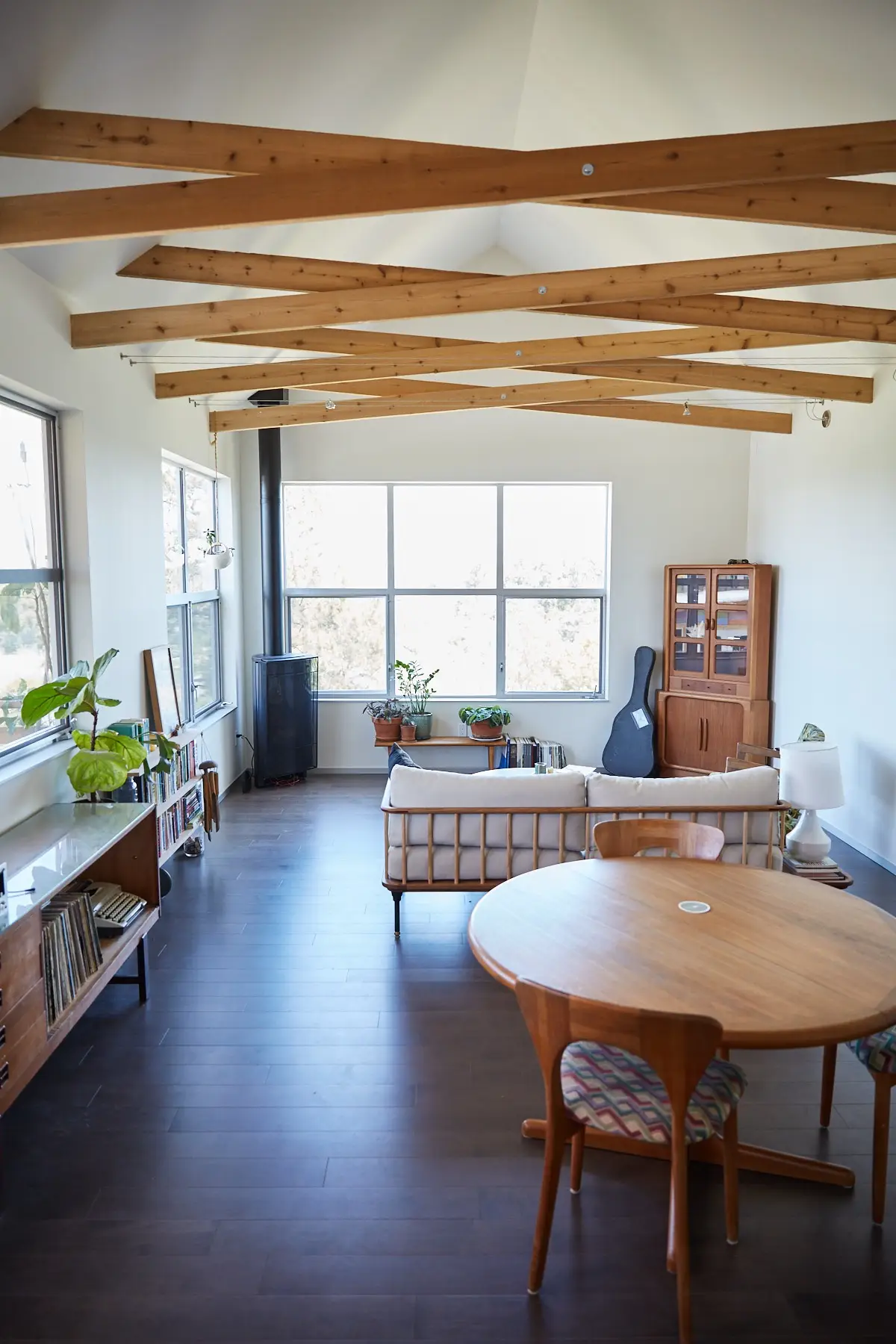
In 1996, Soules founded the Seattle-based Cottage Company, developing “pocket neighborhoods” of single-family dwellings in existing suburban neighborhoods. More recently, after moving back to California, he completed Petaluma’s Keller Court Commons (KCC) just blocks from downtown: an eight-home community of private homes built around a shared green-space landscape. The homes, designed by Chris Lynch of Petaluma’s MAD Architecture and completed in summer 2018, are between 1,400 and 1,700 square feet. That’s the sweet spot size-wise, Soules says, allowing room for a master suite, 2.5 bathrooms, user-friendly kitchen, dining room and living room. Under 1,000 feet, “things get tight,” he says — that half-bath for guests provides some separation for both visitors and yourself — “but anything larger than that, you are adding another bedroom or building bigger rooms.”
For these homes Soules and Lynch chose good insulation and quality windows and siding; solid doors; and kitchen cabinets made of wood, not veneers. Each house is fitted with a full photovoltaic array connecting to a boiler to heat water and has hydronic-heated flooring rather than air-vent heat. The passive solar design includes vertical trellises that block sun in summer and other features that prevent excess warming or cooling. “We wanted to get as close to net zero emissions as possible,” Lynch says. Layout is paramount in these smaller spaces, allowing easy flow between rooms and enough built-in privacy so families can have both alone and together time. “While many people perceive 3,500 feet as ‘quality,’ we have a consciousness that bigger is not always better,” Lynch says. KCC’s homes are not just plain boxes, he notes: “They meet all sorts of needs at any phase of life.”
Dillon Beach Resort
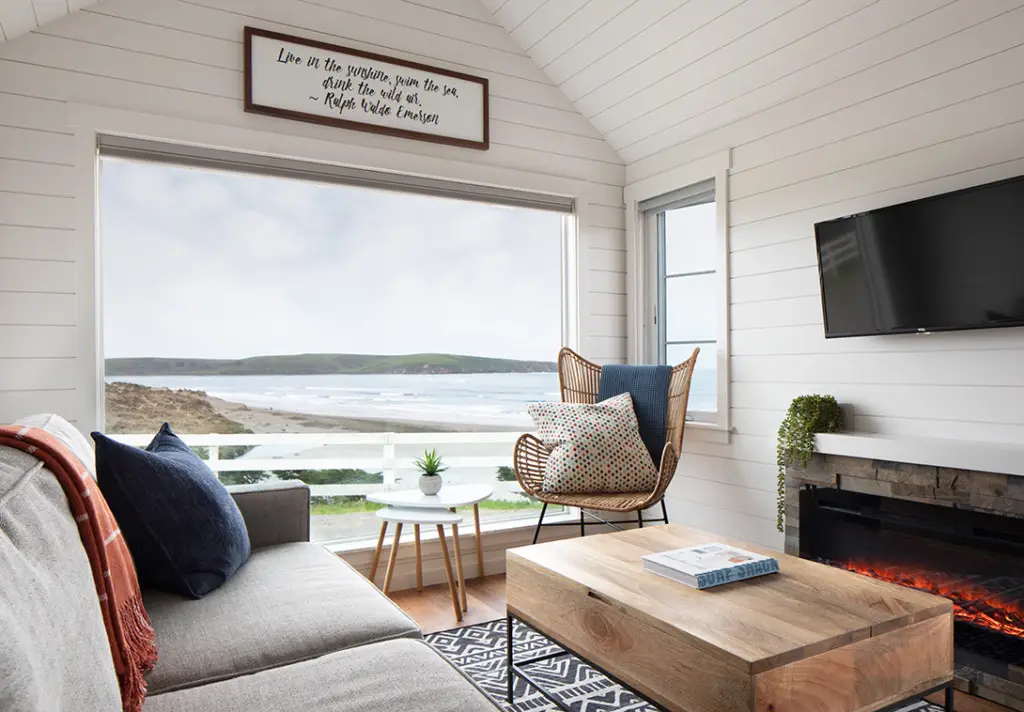
Twenty miles due west of KCC, Dillon Beach Resort recently underwent a complete renovation, bringing small, short-term rental homes to its former recreational vehicle spaces. “It was zoned as an RV park,” says Brooke Gray, the resort’s former director of operations, and she and co-owner Mike Goebel considered placing Airstreams in the property’s 25 former short-term RV slots. But they wanted to honor the area’s famous wind-whipped oceanfront landscape and boost access to the views. “Metal containers seemed wrong for coastal salt air,” Gray adds.
Operating under regulations from the California Coastal Commission, the team researched companies that might create something like the coastal cabins built by resort original owner George Dillon and second owner John Keegan in the 1880s and ’90s. Of the dozens of small home manufacturers across the United States, they picked the Eugene, Oregon, company Tru Form Tiny, whose small travel trailers and park model RVs fit the desired “blending in” aesthetic while allowing Gray and Goebel to custom-design homes for each of the four different footprints they wanted to fill.
Chief among the many design considerations were visual continuity with the main building and not blocking the view of neighbors across the street. Window placement would maximize natural light and ocean views but provide privacy between units. Gray and Goebel worked closely with Tru Form Tiny owner and design lead Malia Schultheis to customize major elements like lay out and smaller aspects like color palette. The park models, while technically RVs, are designed for long-term placement, connected to utilities and attachable to a foundation and have hidden wheels. Private decks were included, accessible only from each tiny home.
Interiors include details like movable peninsulas in the kitchen to quickly reconfigure as prep area or table or be removed altogether to create a dance floor. The homes each “cater toward a social experience of being together,” Schultheis says. That allowed homes to fit on a smaller footprint, as did four-foot-deep shower stalls in most units instead of a five-foot-wide tub. “Bigger bathrooms take other living space away from a tiny home,” Schultheis says. Every space was conceived for versatility and optimal storage: bedrooms with spots for suitcases, a fold-out living room couch in the two-story units. In some homes, the bedroom is downstairs for single-story living.
Tru Form’s customer base is shifting to include both businesses like Dillon Beach and families with babies or small children, Schultheis says —people consciously choosing a life in which they cannot consume as much. “They want nontoxic, high-end materials,” she adds.
The Anchor Inn
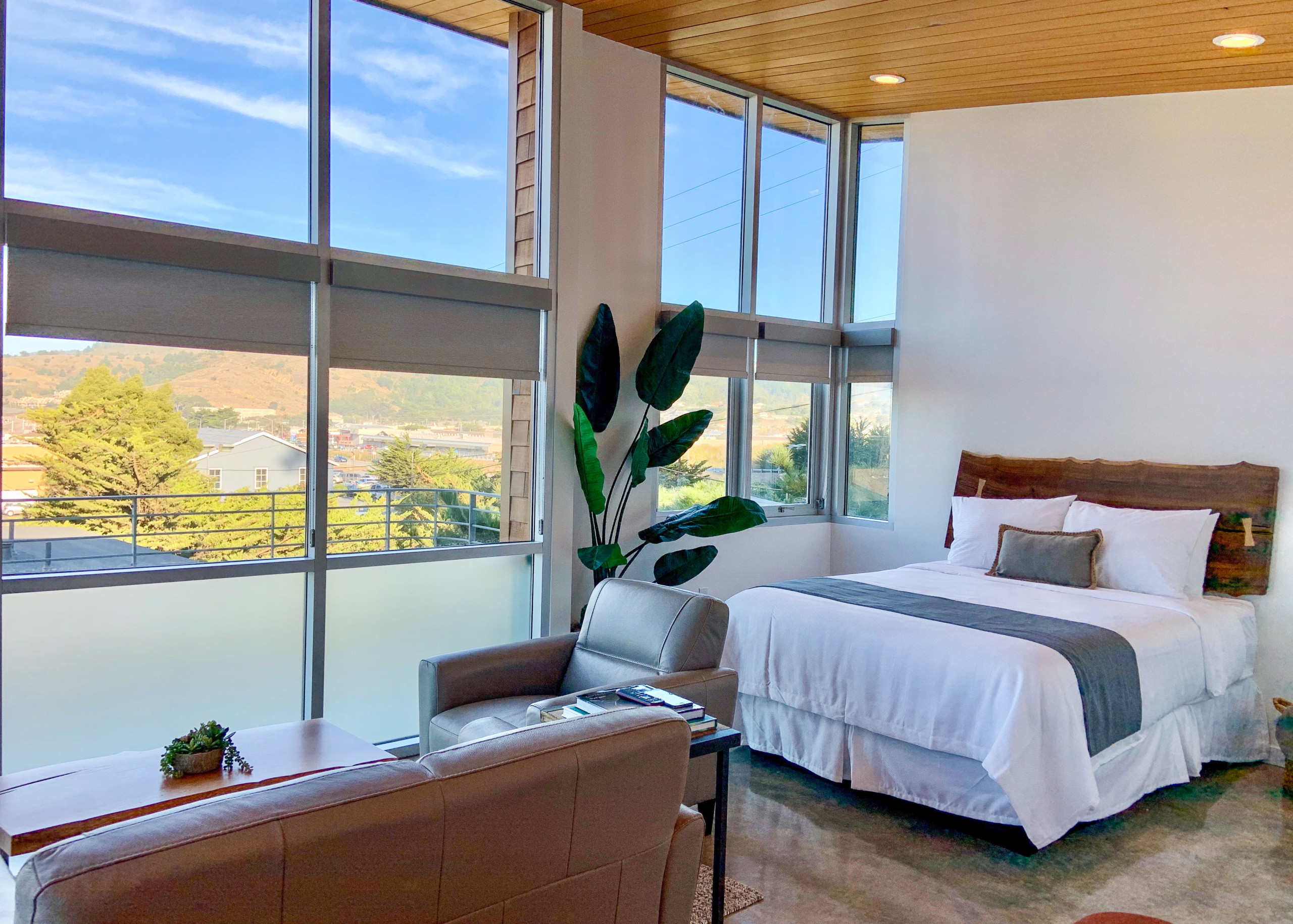
A self-proclaimed modern tiny hotel, the Anchor Inn in Pacifica merges the Airbnb and motel business models. Four cottages, or “mini-villas,” on a hill near the beach are self-check-in and offer a full kitchen (like an Airbnb), yet stays there do come with concierge service, daily cleaning and parking spaces (like a motel). Studio cottages are 450 square feet; one-bedroom suites are 550 square feet. General manager Ella Patel, property owner Dave Colt and architect/designer Dave Blackman planned the spaces with current consumer travel preferences in mind: “a home away from home, but a bit more personalized,” Patel says.
The landscape featured prominently in Blackman’s designs. Floor-to-ceiling windows flood rooms with light, morning till night; double-paned glass helps keep warmth in. Roofs are angled to accommodate rain and provide privacy for units farther down the hill. A floating deck allows outdoor access, and galvanized steel railings create a maritime feel without blocking the view. Inside, the team installed Kohler floating toilets, stall showers, and stackable washer and dryer units In the bathroom. “We put the tanks in the wall to save space,” says Blackman. “We would have lost another foot if we had put in a conventional toilet.” In the kitchen, small appliances and a radiant stovetop minimize energy use. Quartz countertops are virtually stain- and scratch proof and tidily separate kitchen and living areas. A closet near the entry doubles as primary storage and coat closet.
A number of businesses have rented the space for corporate retreats, Patel says, most likely for the modern amenities and ease of use.
Tiny Homes Across the Nation
The Nest, Pheonix Arizona
A small and truly luxurious retreat in Phoenix, Arizona.
Tiny Heirloom
This family-run business out of Portland, Oregon makes stunning tiny homes and even has its own TV show.
Handcrafted Movement
This tiny home company in Portland, Oregon emphasizes craftsmanship in everything they do.
Landark
This Colorado-based company has taken the tiny home and put it on wheels, creating stylish and inventive tiny home RVs.
New Frontier Design
This Nashville, Tennessee tiny home and interior design company began as a father-son duo has often been featured on HGTV.
How to Help
For more ways to support local businesses, go here.
For more on SPACES:
- Mill Valley Architect Chris Dorman’s Passion Project: His Own Home
- New Developments in San Francisco Architecture and Design
- A Noe Valley Craftsman Goes Back to Nature
 Christina Mueller is a long-time Bay Area food writer. She hails from the East Coast and has spent way too much time in South America and Europe. She discovered her talent as a wordsmith in college and her love of all things epicurean in grad school. She has written for Condé Nast Contract Publishing, Sunset, and the Marin Independent Journal, among others. She volunteers with California State Parks and at her child’s school, and supports the Marin Audubon Society, PEN America, and Planned Parenthood. When she is not drinking wine by a fire, she is known to spend time with her extended family.
Christina Mueller is a long-time Bay Area food writer. She hails from the East Coast and has spent way too much time in South America and Europe. She discovered her talent as a wordsmith in college and her love of all things epicurean in grad school. She has written for Condé Nast Contract Publishing, Sunset, and the Marin Independent Journal, among others. She volunteers with California State Parks and at her child’s school, and supports the Marin Audubon Society, PEN America, and Planned Parenthood. When she is not drinking wine by a fire, she is known to spend time with her extended family.
